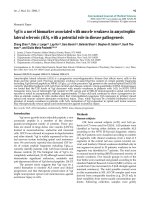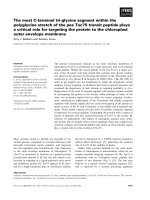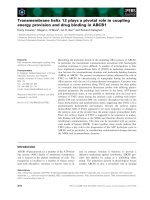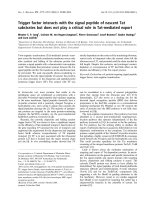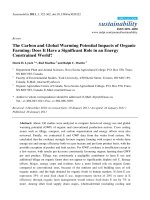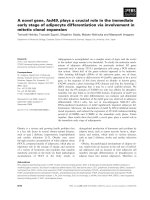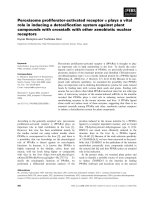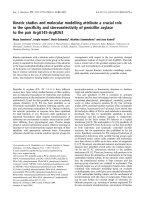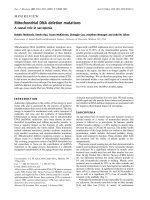Heme oxygenase-1 plays a pro-life role in experimental brain stem death via nitric oxide synthase I/protein kinase G signaling at rostral ventrolateral medulla pps
Bạn đang xem bản rút gọn của tài liệu. Xem và tải ngay bản đầy đủ của tài liệu tại đây (1.58 MB, 12 trang )
RESEARC H Open Access
Heme oxygenase-1 plays a pro-life role in
experimental brain stem death via nitric oxide
synthase I/protein kinase G signaling at rostral
ventrolateral medulla
Kuang-Yu Dai, Samuel HH Chan, Alice YW Chang
*
Abstract
Background: Despite its clinical importance, a dearth of information exists on the cellular and molecular
mechanisms that underpin brain stem death. A suitable neural substrate for mechanistic delineation on brain stem
death resides in the rostral ventrolateral medulla (RVLM) because it is the origin of a life-and-death signal that
sequentially increases (pro-life) and decreases (pro-death) to reflect the advancing central cardiovascular regulatory
dysfunction during the progression towards brain stem death in critically ill patients. The present study evaluated
the hypothesis that heme oxygnase-1 (HO-1) may play a pro-life role as an interposing signal between hypoxia-
inducible factor-1 (HIF-1) and nitric oxide synthase I (NOS I)/protein kinase G (PKG) cascade in RVLM, which sustains
central cardiovascular regulatory functions during brain stem death.
Methods: We performed cardiovascular, pharmacological, biochemical and confocal micro scopy experiments in
conjunction with an experimental model of brain stem death that employed microinjection of the
organophosphate insecticide mevinphos (Mev; 10 nmol) bilaterally into RVLM of adult male Sprague-Dawley rats.
Results: Western blot analysis coupled with laser scanning confocal microscopy revealed that augmented HO-1
expression that was confined to the cytoplasm of RVLM neurons occurred preferentially during the pro-life phase
of experimental brain stem death and was antagonized by immunoneutralization of HIF-1a or HIF-1b in RVLM. On
the other hand, the cytoplasmic presence of HO-2 in RVLM neurons manifested insignificant changes during both
phases. Furthermore, immunoneutralization of HO-1 or knockdown of ho-1 gene in RVLM blunted the augmented
life-and-death signals exhibited during the pro-life phase. Those pretreatments also blocked the upregulated pro-
life NOS I/PKG signaling without affecting the pro-death NOS II/peroxynitrite cascade in RVLM.
Conclusions: We conclude that transcriptional upregulation of HO-1 on activation by HIF-1 in RVLM plays a
preferential pro-life role by sustaining central cardiovascular regulatory functions during brain stem death via
upregulation of NOS I/PKG signaling pathway. Our results further showed that the pro-dead NOS II/peroxynitrite
cascade in RVLM is not included in this repertoire of cellular events.
Background
The observation that asystole invariably takes place
within hours or days after the diagnosis of brain stem
death [1], the legal definition of death stipulated in pro-
fessional or statutory documents from the United
Kingdom [2,3], United States [4], European Union [5] or
Taiwan [6], implies that permanent impairment of the
brain stem cardiovascular regulatory machinery is inti-
mately associated with this fatal phenomenon. It is
the refore intriguing that based on power spectral analy-
sis of systemic arterial pressure (SAP) signals from
comatose intensive care unit patients [7-9], our labora-
tory found previously that a dramatic reduction or loss
of the power density of the low-frequency (LF)
* Correspondence:
Center for Translational Research in Biomedical Sciences, Chang Gung
Memorial, Hospital-Kaohsiung Medical Center, Kaohsiung County 83301,
Taiwan
Dai et al. Journal of Biomedical Science 2010, 17:72
/>© 2010 Dai et al; licensee BioMed Central Ltd. This is an Open Access article dis tributed under the terms of the Creative Commons
Attribution License ( which permits unrestricted use, distribution, and reproduction in
any medium, provided the original work is properly cited.
component, which reflects dysfunction of central circu-
latory control, consistently occurs before brain stem
death ensues. It follows that delineation of the cellular
and molecular mechanisms that underpin the impending
impairment of brain stem cardiovascular regulatory
machinery should enrich the dearth of mechanistic
information currently available on b rain stem death. A
logical neural substrate for this delineation resides in
the rostral ventrolateral medulla (RVLM), which is long-
known to b e responsible for the maintenance of sympa-
thetic vasomotor tone and stable SAP [10] and is the
origin of the LF component [11] that presents itself as
the life-and-death signal that disappears before brain
stem death [12].
Mevinphos (3-(dim ethoxyphosphinyl-oxyl)-2-butenoic
acid methyl ester; Mev), a US Environmental Protection
Agency Toxicity Category I pesticide, has been used in
our laboratory as the experimental insult in an animal
model for mechanistic evaluations of brain stem death
[12-14] for two reasons. Systemic administration of Mev
acts on RVLM to elicit cardiovascular toxicity [15].
More importantly, the distinct phases o f an augmenta-
tion followe d by a reduction of the LF power manifested
during Mev intoxication resemble those exhibited by
patients died of organophosphate poisoning dur ing the
progression towards brain stem death [9]. As such, t hey
can be designated the pro-life and pro-death phase of
cardiovascular regulation in this model of brain stem
death [12]. Based on this model, our laboratory has pre-
viously reported that nitric oxide (NO) generated by NO
synthase I (NOS I ) in RVLM, followed by activation of
the soluble guanylyl cyclase/cGMP/protein kinase G
(PKG) cascade, is responsible for the pro-life phase; per-
oxyni trite formed by a reaction between NOS II-derived
NO and superoxide anion underlies the pro-death phase
[16,17]. On the other hand, NOS III in RVLM is not
engaged in either the pro-life or pro-death phase of the
Mev intoxication model of brain stem death [16].
Another pro-life program that our laboratory [13] iden-
tified in RVLM during brain stem death is heat shock pro-
tein 70 (HSP70), which ameliorates cardiovascular
regulatory dysfunction via enhancing NOS I/PKG signal-
ing and inhibiting NOS II/peroxynitrite cascade. We also
showed previously that hypoxia-inducible factor-1 (HIF-1)
acts as an upstream signal for HSP70 in RVLM during the
pro-life phase of experimental brain stem death [18]. In
addition, heme oxygenase-1 (HO-1) [19-21], and both
NOS I [21,22] and NOS II [20,23] are known to be
hypoxia responsive gene products; upregulation of HO-1
is mediated transcriptionally on HIF-1a activation [24,25].
A logical extension from those observations is that
HO-1mayplayapro-liferoleinexperimentalbrain
stem death by interacting o n one hand with HIF-1 and
on the other with NOS I/PKG or NOS II/pero xynitrite
signaling pathway in RVLM. The present study evalu-
ated this hypothesis. Based on our Mev intoxication
model, we demonstrated that on activation by HIF-1,
HO-1 plays a preferential pro-life role in brain stem
death by sustaining central cardiovascular regulatory
functions via upregulation of NOS I /PKG signaling
pathway in RVLM.
Methods
All experimental p rocedures carried out in this study
have been approved by the Laboratory Animal Commit-
tee of the Chang Gung Memorial Hospital-Kaohsiung
Medical Center, and were in compliance with the guide-
lines for animal care set forth by this Committee.
Animals
Adult male Spra gue-Dawley rats (289 to 337 g, n = 3 16)
purchased from the Experimental Animal Center of the
National Science Council, Taiwan, Republic of China
were used. Rats received preparatory surgery under an
induction dose of pentobarbital sodium (50 mg kg
-1
, i.p.).
During the experiment, animals received continuous
intravenous infusion of propofol (20-25 mg kg
-1
h
-1
;
Zeneca, Macclesfield, UK), which provided satisfactory
anesthetic maintenance while preserving the capacity of
central cardiovascular regulation [26]. They were allowed
to breathe spontaneously with room air, and body tem-
perature was maintained at 37°C by a heating pad.
Mev intoxication model of brain stem death
SAP signals recorded from the femoral artery were sub-
ject to simultaneous on-line and real-time power spec-
tral analysis [13-17,27], using a computer algorithm
developed by our laboratory [28] that is specifically
designed to deal with non-stationary signals encoun-
tered in clinical [7-9] and laboratory [13-17,27] settings.
We were pa rticu larly interested in the LF (0.2 5-0.8 Hz)
component of the SAP spectrum becau se it takes origin
from RVLM [11] and t he biphasic changes in LF power
reflect the pro-life and pro-death phases during th e pro-
gression towards brain stem death [12]. Heart rate (HR)
was derived instantaneously from SAP signals. Since
Mev induces comparable cardiovascular responses when
given systemically or directl y to RVLM [15], we routi-
nely microinjected Mev bilaterally into RVLM to elicit
site-specific effects [13-17,27]. Temporal changes in pul-
satile SAP, mean SAP (MSAP), HR and p ower density
of the LF component were routinely followed for 180
minaftertheadministrationofMev,inanon-lineand
real-time manner.
Microinjection of test agents
Microinjection bilaterally of test agents into the RVLM,
each at a volume of 50 nl, was carried out stereot axically
Dai et al. Journal of Biomedical Science 2010, 17:72
/>Page 2 of 12
and sequentially [13-17,27,29] via a glass micropipette
connected to a 0.5-μl Hamilton microsyrin ge (Reno, NV,
USA). The coordinates used were: 4.5-5 mm posterior to
lambda, 1.8-2.1 mm lateral to midline, and 8.1-8.4 mm
below the dorsal surface of cerebellum. Test agents
employed included Mev ( kindly provided by Huikwang
Corporation, Tainan, Taiwan) and artificial cerebrospinal
fluid(aCSF)thatservedasthevehiclecontrol.Arabbit
polyclonal ant iserum against HIF-1a (Novus Biologicals,
Littleton, CO, USA), HIF-1b (Lifespan Biosciences, Seattle,
WA, USA), HIF-2a (Novus), HO-1 (Calbiochem, San
Diego, CA, U SA) or HO-2 (Santa Cruz, Santa Cruz, CA,
USA) was used to affect immunoneutralization. As in pre-
vious studies [13,14], 0.02% Triton X-100 (Sigma-Aldrich,
St.Louis,MO,USA)wasaddedto facilitate transport of
the antiserum across the cell membrane of RVLM neu-
rons. Microinjection of normal rabbit serum (NRS; Sigma-
Aldrich) plus 0.02% Triton X-100 served as the vehicle
control. To avoid v erbose presentation, however, the
phrase 0.02% Triton X-100 is omitted from subsequent
narration. Gene knockdown was executed using an anti-
sense oligonucleotide (Quality Systems, Taipei, Taiwan)
that targets against the coding region (base +10 to -9)
of the ho-1 gene [30]: 5′ -GGCGCTCCATCGCGG-
GACTG-3′; or the coding region (base +11 to -9) of the
ho-2 gene [30]: 5′-TCTGAAGACATTGTTGCTGA-3′ .
The corresponding sense o ligonucleotide: 5′ -TCCAG
CGGCGTCAGCGGTGC-3′ (ho-1)or5′-GATCTGACTT-
CAAG TGATTG-3′ (ho-2) or scrambled oligonucleotide:
5′-CAGTCCCGCGATGGAGCGCC-3′ (ho-1)or5′-TCAG
CAACAATGTCTTCAGA-3′ (ho-2) was used as the con-
trol. The dose and treatment regimen were adopted from
the literat ure that used the oligonucleotides for the same
purpose as in the present study. To avoid the confounding
effects of drug interactions, each animal received only one
antiserum or oligonucleotide pretreatment.
Collection of tissue samples
We routinely collected tissue samples [13,14,16,17] during
the peak of the pro-life and pro-death phase (Mev group)
or 30 or 180 min after microinjection of aCSF into RVLM
(vehicle group). Animals were killed with an overdose of
pentobarbital sodium, and tissues on both sides of the ven-
trolateral part of medulla oblongata, at the level of RVLM
(0.5-2.5 mm rostral to the obex), were collected by micro-
punches made with a stainless steel bore (1 mm i.d.) and
frozen in liquid nitrogen. Medullary tissues collected from
anesthetized animals but without treatment served as the
sham controls. Protein in the extracts was estimated by
BCA Protein Assay (Pierce, Rockford, IL. USA).
Protein expression
We employed Western blot analysis [13,14,16,17] to
detect expression level of HO-1, HO-2, NOS I, PKG,
NOS II or nitrotyrosine (marker for peroxynitrite) pro-
tein. The primary antiserum used for HIFs or HOs were
the same as those used for immunoneutralization. The
other primary antisera used included a rabbit polyclonal
antiserum against NOS I (Santa Cruz), NOS II (Santa
Cruz), PKG (Calbiochem); or a mouse monoclona l anti-
serum against nitrotyrosine (Upstate Biotechnology,
Lake Placid, NY) or b-actin (Chemicon, Temecula, CA,
USA). The secondary antisera used included horseradish
peroxidase-conjugated donkey anti-rabbit IgG
(Gehealthcare, Uppsala, Sweden) for HO-1, HO-2, NOS
I, NOS II, PKG; or horseradish peroxida se-conjugated
sheep anti-mouse IgG (Gehealthcare) for nitrotyrosine
or b-actin. The amount of protein was quantified by the
ImageMaster software ( Amersham Pharmacia Biotech,
Buckinghamshire, UK), and was expressed as the ratio
relative to b-actin protein. Densitometric values that
were not statistically different from the background
were designated below detection limits.
Immunofluorescence staining and confocal microscopy
We employed double immunofluorescence staining
coupled with laser scanning confocal microscopy [13,14]
to detect subcellular localization of HO-1 or HO-2 in
RVLM ne urons labeled wi th a mouse monoclonal anti-
serum against a specific neuron marker, neuron-spe cific
nuclear protein (NeuN; Millipore, Billerica, MA, USA).
Secondary antisera (Molecular Probes, Eugene, OR,
USA) used included a goat anti-rabbit IgG conjugated
withAlexaFluor568forHO-1orHO-2,andagoat
anti-mouse IgG conjugated with Alexa Fluor 488 for
NeuN. Tissues similarly processed but omitting primary
antiserum against HO isoforms served as our negative
controls. Immunoreactivity was viewed under a Fluor-
view FV1000 laser scanning confocal microscope (Olym-
pus, Tokyo, Japan).
Histology
In some animals that were not used for biochemical
analysis, the brain stem was removed at the end of the
physiological experiment and fixed in 30% sucrose in
10% formaldehyde-saline solution for at least 72 h. Fro-
zen 25-μm sections of the medulla oblongata stained
with neural red were used for histolo gical verification of
the microinjection sites.
Statistical analysis
All values are expressed as the mean ± S.E.M. The
effects of various treatments on the averaged value of
MSAP or HR calculated every 20 min after administra-
tion of test agents or vehicle, the sum total of power
density for LF component in the SAP spectra over 20
min, or the protein expression level in the ventrolateral
medulla during each pha se of Mev intoxication, were
Dai et al. Journal of Biomedical Science 2010, 17:72
/>Page 3 of 12
used for statistical analysis. One-way or 2-way ANOVA
with repeated measures was used, as appropriate, to
assess group means. This was fol lowed by the Scheffé
multiple-range test for post hoc assessment of individual
means. P < 0.05 was considered to be statistically
significant.
Results
Biphasic cardiovascular responses in experimental brain
stem death
Figure 1 shows that co-microinjection bilaterally of Mev
(10 nmo l) and vehicle into RVLM elicit ed a progressive
hypotension that became significant 100 min after appli-
cation, accompanied by insignif icant alterations in HR.
Concurrent changes in power density of the LF
component of SAP signals revealed two distinct phases
of Mev-induced cardiovascular responses. The pro-life
Phase I entailed a significantly augmented LF power
that endured 80-100 min. The pro-death Phase II,
which lasted the remainder of our 180-min observation
period, exhibited further and significant reduction in the
power density of this spectral component to below base-
line to reflect failure of brain stem cardiovascular regu-
latory functions that precedes brain stem death [12].
Preferential upregulation of HO-1 in RVLM during the
pro-life phase
The fundamental premise for HO-1 in RVLM to play a
pro-life role in brain stem death is for it to be upregu-
lated selectively during the pro-life phase in the Mev
Figure 1 Transcriptional upregulation of HO-1 in RVLM ameliorates failure of central cardiovascular regulation associated with
experimental brain stem death. Temporal changes in mean systemic arterial pressure (MSAP), heart rate (HR) or power density of the low-
frequency (LF) component of SAP signals in rats that received pretreatment by microinjection bilaterally into RVLM of NRS (1:20) or HO-1
antiserum (1:20); or aCSF, scrambled (SC; 50 pmol), sense (S; 50 pmol) or antisense (AS; 50 pmol) ho-1 oligonucleotide (right column), 1 h or 24 h
before local application (at arrow) of aCSF or Mev (10 nmol) to the bilateral RVLM. Values are mean ± SEM, n = 5-7 animals per experimental
group. *P < 0.05 versus NRS+aCSF or aCSF+aCSF group, and
+
P < 0.05 versus NRS+Mev or aCSF+Mev group at corresponding time-points in the
Scheffé multiple-range test.
Dai et al. Journal of Biomedical Science 2010, 17:72
/>Page 4 of 12
intoxication model. Our first series of experiments
assessed this fundamental premise. Compared to aCSF
controls, microinjection bilaterally of Mev (10 nmol)
into RVLM significantly increased HO-1 protein expres-
sion (Fig. 2A) in ventrolateral medulla during Phase I,
which returned to baseline during Phase II. On the
other hand, HO -2 expression (F ig. 2A) rem ained rela-
tively constant during both phases.
Preferential upregulation of HO-1 in RVLM neurons
during the pro-life phase
Double immunof luorescence staining coupled with l aser
scanning confocal microscopy further revealed that the
differential changes in HO-1 and HO-2 demonstrated in
our biochemical analyses on protein extracts from ven-
trolateral medulla indeed took place at the neuronal
level. Against a clearly defined nucleus and nucleolus in
cells stained positively with the neuronal marker, neu-
ron-specific nuclear protein (NeuN), the surge in HO-1
immunoreactivity during the pro-life phase was confined
to the cyt oplasm (Fig. 3), which subsided during Phase
II. Again, the cytoplasmic presence of HO-2 in RVLM
neurons exhibited indiscernible changes during both
phases (Fig. 3).
Preferential transcriptional upregulation of HO-1 by HIF-1
in RVLM during the pro-life phase
HO-1 is a well-known gene target that is regulated tran-
scriptionally by HIF-1 [24,25]. Loss-of-function manipu-
lation by immunoneutralization of HIF-1a or H IF-1b in
RVLM significantly and selectively antagonized the
Mev -induced augmentatio n of HO-1 protein expression
in ventrolateral medulla during Phase I (Fig. 2A); anti-
HIF-2a antiserum was ineffective in both phases (Fig.
2A). As an additional support for this observation, we
extended results from a parallel study ( unpublished
data), which showed that augmented sumoylation of
HIF-1a [31-34] is causally related to its enhance d stabi-
lity or transcriptional activity in RVLM during the pro-
life phase. Thu s, immunoneutralization of SUMO-1 or
Ubc9 (the only known conjugating enzyme for the
sumoylation pathway) in RVLM (Fig. 2B) also signifi-
cantly blunted the preferential upregulation of HO-1 in
ventrolateral medulla during the pro-life phase.
Activation of HO-1 in RVLM ameliorates failure of central
cardiovascular regulation associated with experimental
brain stem death
We next employed immunoneutralization or gene-
knockdown to establish that selective activation of HO-
1 in RVLM is causally involved in central cardiovascular
regulation during brain stem death. Pretreatment with
microinjection bilaterally into RVLM of an anti-HO-1
antiserum or an antisense ho-1 oligonucleotide (Fig. 1),
given 1 h or 24 h before local application of Mev
(10 nmol), significantly and selectively potentiated the
hypotension and antagonized the augmented LF power
exhibited during Phase I; the hypotension and reduced
LF power manifested during Phase II was further signifi-
cantly enhanced. On the other hand, pretreatment with
the same dose of anti-HO-2 (Fig. 4) antiserum, antisense
oligonucleotide against ho-2 gene (Fig. 4), or sense or
scrambled ho-1 (Fig. 1) or ho-2 (F ig. 4) oligonucleotide
was ineffective against the phasic cardiovascular
responses induced by Mev.
Activation of HO-1 leads to phasic upregulation of
NOS I/PKG signaling in RVLM
We demonstrated previously [13,14,16,17] that whereas
NOS I/PKG signaling in RVLM is responsible for t he
pro-life phase, NOS II/peroxyn itrite signaling underlies
the pro-death phase of Mev intoxication. Our final ser-
ies of experiments assessed whether HO-1 may sub-
serve its pro-life role via modulation of these two
signaling pathways. Immunoneutralization of HO-1
(Fig. 5) or knockdown of ho-1 gene (Fig. 5) blunted
significantly and selectively the Mev-induced Phase I
increase in NOS I or PKG protein expression in ven-
trolateral medulla. None of these pretreatments
affected the progressive increase in NOS II or nitrotyr-
osine (marker for peroxynitrite) during both phases of
Mev intoxication. Again, a nti-HIF-2a or anti-HO-2
antiserum, antisens e ho-2 oligonucleotide, or sense or
scrambled ho-1 or ho-2 oligonucleotide was ineffective
(Figs. 5 and 6) against the phasic Mev-induced NOS I,
PKG, NOS II or nitrotyrosine protein expression in
ventrolateral medulla.
Effectiveness of gene knockdown
We also ascertained that our results from gene knock-
down with antisense ho-1 oligonucleotide (Figs. 1 and 5)
were accompanied by significant antagonism against the
increase in HO-1 expression in ventrolateral medul la
during Phase I Mev intoxication (Fig. 6), and sense or
scrambled ho-1 oligonucleotide was ineffective. Likewise,
the lack of alterations in H O-2 levels was not affected
by pretreatment with antisense, sense or scrambled ho-2
(Fig. 6) oligonucleotide.
Discussion
Based o n a clinically relevant experimental model [12],
we demonstrated that on transcriptional activation by
HIF-1, HO-1 plays a preferential pro-life role during the
progression towards brain stem death by sustaining cen-
tral cardiovascular regulatory functions via upregulation
of the NOS I/PKG signaling cascade i n RVLM. We
further showed that the engagement of HO-2 at RVLM
in this process is minimal.
Dai et al. Journal of Biomedical Science 2010, 17:72
/>Page 5 of 12
Figure 2 Preferential transcriptional upregulation of HO-1 by HIF-1 in RVLM during the pro-life phase. A. Illustrative gels or summary of
fold changes against aCSF controls in ratio of HO-1 or HO-2 relative to b-actin protein detected in ventrolateral medulla of rats that received
immunoneutralization of HIF-1a, HIF-1b or HIF-2a subunit in RVLM, 1 h before induction of Mev intoxication. B. Illustrative gels or summary of
fold changes against aCSF controls of HO-1 expression detected in ventrolateral medulla of rats that received immunoneutralization of SUMO-1
or Ubc9, 1 h before induction of Mev intoxication. Values in A and B are mean ± SEM of triplicate analyses on samples pooled from 4-6 animals
per experimental group. *P < 0.05 versus aCSF group and
+
P < 0.05 versus Mev group in the Scheffé multiple-range test. Note that dividing lines
are placed on the gel images to denote groupings of images from different parts of the same gel. Note also that numbers on top of the gels in
B correspond to columns in the data summary.
Dai et al. Journal of Biomedical Science 2010, 17:72
/>Page 6 of 12
Both HO-1 and HO-2 are ubiquitously and catalyti-
cally active enzymes involved in the degradation of
heme [35]. Whereas HO-2 is constitutive ly expressed
under homeostatic conditions, HO-1 is an inducible iso-
form that is responsive to hypoxia or oxidative stress.
As an antioxidant enzyme, HO-1 acts against oxidative
stress by metabolizing heme to biliverdin, iron (Fe
2+
)
and carbon monoxide [36]. It plays a neuroprotective
role in mouse hippocampal neuron-derived HT22 cell
line that is exposed to oxidative glutamate toxicity [37],
or in homozygous HO-1 transgenic mice that are sub-
ject to middle cerebral artery occlusion [38]. Our labora-
tory reported previously [13] that severe tissue hypoxia,
but not tissue hypo-perfusion, takes place in RVLM dur-
ing Phase I Mev intoxication. It is therefore of interest
that we found that activation of HIF-1 is causally related
to the preferential upregulation of HO-1 in RVLM dur-
ing the pro-life phase. H IF-1 is a heterodimer of two
basic helix-loop-helix/PAS proteins, HIF-1a and HIF-1b
[39]. Hypoxia stabilizes HIF-1a, and nucle us-bound
translocation of the stabilized HIF- 1a allows for forma-
tion of the HIF-1ab heterodimer that becomes tran-
scriptionally active [40]. The activated HIF-1ab complex
binds to target genes at hypoxia regulatory element
(HRE), which contains th e core recognition sequence 5′-
RCGTG-3′, leading to upregulation of hypoxia respon-
sive gene products such as ho-1 [20]. Our results from
loss-of-function manipulations of HIF-1a or H IF-1b
showed that activation of HIF-1ab complex leads to
augmented HO-1 protein expression in RVLM neurons
during the pro-life phase. Results from immunoneutrali-
zation of HO-1 protein or knockdown of ho-1 gene in
RVLM further confirmed that this transcriptionally
upregulated HO-1 is causally and preferentially related
to sustaining central cardiovascular regulation during
experimental brain stem death. On the o ther hand, our
results indicated that whereas HO-2 is cytoprotective via
phosphorylation by protein kinase C [ 41] and is present
in RVLM neurons, it is minimally engaged in the cellu-
lar processes that underlie brain stem death.
Our results further lend credence to the notion that
HO-1 acts as an intermediate between HIF-1 activation
and t he pro-life NOS I/PKG pathway in RVLM. NOS I
[21,22] is k nown to be a hypoxia responsive gene pro-
duct activated by HIF-1. Hypoxia increases NOS I
expression that parallels activation of HIF-1a in piglet
ventricular tissues [21]. An increase in NOS I mRNA
and protein and HIF-1a protein expression also occurs
in cerebral cortex of anemic rats [22]. The elevated NO
level in hypoxic corpus ca llosum [42] or retina [43] is
accompani ed by an increase in mR NA and protein
expression of HIF-1a and NOS I. Inductio n of HO-1
also rapidly restores NOS I expression in interstitial
cells of Cajal and prevents oxidative stress in mice [44].
Of note is that the promoter region of nos I gene lacks
HRE [45], the target site for HIF-1.Thus, it is of interest
Figure 3 Preferential upregulation of HO-1 in RVLM neurons during the pro-life phase. Illustrative laser scanning confocal microscopic
images showing cells in RVLM that were immunoreactive to NeuN (green fluorescence) and additionally stained positively for HO-1 or HO-2
isoform (red fluorescence) in sham controls (Basal) or during Phases I and II Mev intoxication. *Denotes location of nucleus in corresponding
RVLM neuron. These results are typical of 4 animals from each experimental group. Scale bar, 10 μm.
Dai et al. Journal of Biomedical Science 2010, 17:72
/>Page 7 of 12
that by showing that immunoneutralization of HO-1
protein or knockdown of ho-1 gene blunted the surge of
NOS I or PKG expression in RVLM during Phase I Mev
intoxication, the present study demonstrated that HO-1
acts as the interposing signal between upregulation of
HIF-1 and NOS I activation. Our laboratory showed
previously that on activation by the HIF-1/HO-1 cascade
[18], HSP70 ameliorates cardiovascular regulatory dys-
function during experimental brain stem death via
enhancing NOS I/PKG signaling in RVLM [13]. It fol-
lows that the repertoire of cellular signals in RVLM dur-
ing the pro-life phase of experimental brain stem death
entails transcriptional upregul ation of HO-1 by HIF-1,
followed by activation of HSP70 that leads to sustained
brain stem cardiovascular regulatory functions by the
enhanced NOS I/PKG signaling.
Previous studies from our laboratory [16,17] demon-
strated that the NOS II/peroxynitrite cascade in RVLM
underlies central cardiovascular regulatory failure during
the pro-death phase of experimental brain stem death.
NOS II is also a well-known hypoxia responsive gene
product [20,22]. Melillo et al. [46] showed that a
sequence homologous to a hypoxia-resp onsive enhancer
(NOS II-HRE) is responsible for activation of nos II
gene in murine macrophages. A putative HIF-1 site
(CTACGTGCT) in the murine NOS II gene was
Figure 4 Lack of effect of HO-2 in RVLM on failure of central cardiovascular regulation associated with experimental brain stem death.
Temporal changes in MSAP, HR or power density of the LF component of SAP signals in rats that received pretreatment by microinjection
bilaterally into RVLM of normal rabbit serum (NRS; 1:20) or HO-2 antiserum (1:20); or aCSF, scrambled (SC; 50 pmol), sense (S; 50 pmol) or
antisense (AS; 50 pmol) ho-2 oligonucleotide (right column), 1 h or 24 h before local application (at arrow) of aCSF or Mev (10 nmol) to the
bilateral RVLM. Values are mean ± SEM, n = 5-7 animals per experimental group. *P < 0.05 versus NRS+aCSF or aCSF+aCSF group, and
+
P < 0.05
versus NRS+Mev or aCSF+Mev group at corresponding time-points in the Scheffé multiple-range test.
Dai et al. Journal of Biomedical Science 2010, 17:72
/>Page 8 of 12
Figure 5 Transcriptional activation of HO-1 leads to preferential upregulation of NOS I /PKG signaling in RVLM .Illustrativegelsor
summary of fold changes against aCSF controls in ratio of nitric oxide synthase I (NOS I), protein kinase G (PKG), NOS II or nitrotyrosine (NT)
relative to b-actin protein detected in ventrolateral medulla of rats that received immunoneutralization of HO-1 or HO-2, or knockdown of ho-1
or ho-2 gene in RVLM, 1 h or 24 h before induction of Mev intoxication. Note that NT is presented as % relative to b-actin because it is below
detection limit (ND) in aCSF controls. Values are mean ± SEM of triplicate analyses on samples pooled from 4-6 animals per experimental group.
*P < 0.05 versus aCSF group and
+
P < 0.05 versus Mev group in the Scheffé multiple-range test.
Dai et al. Journal of Biomedical Science 2010, 17:72
/>Page 9 of 12
subsequently shown to be crucial for hypoxia-induced
transcription in pulmonary arter y endothelial cells [47]
or cardiomyocytes [48]. Hypoxia-induced NOS II pro-
tein expression is transcriptionall y upregulated by of
HIF-1a in hippocampus of rats that received permanent
middle cerebral artery occlusion [49]. However, since
immunoneutralizat ion of H O-1 protein and knockd own
of ho-1 gene did not significantlyaffecttheprogressive
augmentation of NOS II or nitrotyrosine levels in
ventrolateral medulla during experimental brain stem
death, the participation of HIF-1/HO-1 as cellular sig-
nals upstream to NOS II/peroxynitrite cascade is
deemed minimal.
We recognize that the effectiveness of immunoneutra-
lization depends on the specificity of the antiserum
used. In this regard, the HIF-1a, HIF-1b, HIF-2a, HO-1
or HO-2 antiserum employed in the present study are
all d irected specifically against their respective antigens
Figure 6 Knockdown of ho-1 gene antagonized select ively the activation of HO-1 in RVLM. Illustrative gels or summary of fold changes
against aCSF controls in ratio of HO-1 (A) or HO-2 (B) relative to b-actin protein detected in ventrolateral medulla of rats that received
knockdown of ho-1 or ho-2 gene in RVLM 24 h before induction of Mev intoxication. Values are mean ± SEM of triplicate analyses on samples
pooled from 4-6 animals per experimental group. *P < 0.05 versus aCSF group and
+
P < 0.05 versus Mev group in the Scheffé multiple-range
test. Note that dividing lines are placed on the gel images to denote groupings of images from different parts of the same gel.
Dai et al. Journal of Biomedical Science 2010, 17:72
/>Page 10 of 12
and do not cross-react with each other or other unre-
lated signaling systems. The same goes with the anti-
sense oligonucle otides used to knock down ho-1 or ho-2
gene. The observations, for example, that immunoneu-
tralization or gene knockdown of HO-1 exerted compar-
able effects on cardiovascular responses (Fig. 1) and
NOS I/PKG signaling (Fig. 5), but not NOS II/peroxyni-
trite cascade (Fig. 5) during Mev intoxication further
attest to the specificity of these t reatments. The use of
conditional knockout mouse model, which in essence is
similar to antisense oligonuc leotide treatment at RVLM,
is an other method of pretreatment. However, since our
animal model of brain stem death is based on the rat,
this approach was not adopted because of the concern
for species difference.
Conclusions
We conclude that transcriptional upregulation of HO-1
on activation of H IF-1 in RVLM plays a preferential
pro-life role by sustaining cardiovascular regulatory
functions during brain stem death via upregulation of
NOS I/PKG signaling pathway. Our results further
showed that NOS II/peroxynitrite signaling is not
included in this repertoire of cellular events. This infor-
mation should provide further insights on the etiology
of brain stem death, and offer new directions for the
development of therapeutic strategy against this fatal
eventuality.
Acknowledgements
Supported by research grants NSC97-2320-B-182A-007-MY3 (SHHC) and
NSC96-2320-B-182A-016-MY3, NSC97-2321-B-182A-006 and NSC98-2321-B-
182A-003 (AYWC) from the National Science Council, Taiwan, Republic of
China.
Authors’ contributions
KYD performed the cardiovascular experiments and carried out Western blot
analysis and confocal microscopy. SHHC and AYWC conceived the study,
participated in experimental design, and drafted and revised the manuscript.
All authors have read and approved the final manuscript.
Competing interests
The authors declare that they have no competing interests.
Received: 27 July 2010 Accepted: 7 September 2010
Published: 7 September 2010
References
1. Pallis C: ABC of Brain Stem Death London: British Medical Journal Press 1983.
2. Diagnosis of brain death. Statement issued by the honorary secretary of
the Conference of Medical Royal Colleges and their Faculties in the
United Kingdom on 11 October 1976. Br Med J 1976, 2:1187-1188.
3. Diagnosis of death. Memorandum issued by the honorary secretary of
the Conference of Medical Royal Colleges and their Faculties in the
United Kingdom on 15 January 1979. Br Med J 1979, 1:332.
4. Report of the Medical Consultants on the Diagnosis of Death to the
President’s Commission for the Study of Ethical Problems in Medicine
and Biomedical and Behavioral Research. J Am Med Assoc 1981,
246:2184-2186.
5. Haupt WF, Rudolf J: European brain death codes: a comparison of
national guidelines. J Neurol 1999, 246:432-437.
6. Hung TP, Chen ST: Prognosis of deeply comatose patients on ventilators.
J Neurol Neurosurg Psychiatry 1995, 58:75-80.
7. Kuo TBJ, Yien HW, Hseu SS, Yang CCH, Lin YY, Lee LC, Chan SHH:
Diminished vasomotor component of systemic arterial pressure signals
and baroreflex in brain death. Am J Physiol 1997, 273:H1291-H1298.
8. Yien HW, Hseu SS, Lee LC, Kuo TBJ, Lee TY, Chan SHH: Spectral analysis of
systemic arterial pressure and heart rate signals as a prognostic tool for
the prediction of patient outcome in intensive care unit. Crit Care Med
1997, 25:258-266.
9. Yen DHT, Yien HW, Wang LM, Lee CH, Chan SHH: Spectral analysis of
systemic arterial pressure and heart rate signals of patients with acute
respiratory failure induced by severe organophosphate poisoning. Crit
Care Med 2000, 28:2805-2811.
10. Spyer KM: Central nervous mechanisms contributing to cardiovascular
control. J Physiol 1994, 474:1-19.
11. Kuo TBJ, Yang CCH, Chan SHH: Selective activation of vasomotor
component of SAP spectrum by nucleus reticularis ventrolateralis in rats.
Am J Physiol 1997, 272:H485-H492.
12. Chan JYH, Chang AYW, Chan SHH: New insights on brain stem death:
From bedside to bench. Prog Neurobiol 2005, 77:396-425.
13. Chan JYH, Cheng HL, Chou JLJ, Li FCH, Dai KY, Chan SHH, Chang AYW:
Heat shock protein 60 or 70 activates NOS 1- and inhibits NOS II-
associated signaling, and depresses mitochondrial apoptotic cascade
during brain stem death. J Biol Chem 2007, 282:4585-4600.
14. Chan JYH, Wu CHY, Tsai CY, Cheng HL, Dai KY, Chan SHH, Chang AYW:
Transcriptional up-regulation of nitric oxide synthase II by nuclear
factor-B at rostral ventrolateral medulla in a rat mevinphos intoxication
model of brain stem death. J Physiol 2007, 581:1293-1307.
15. Yen DHT, Yen JC, Len WB, Wang LM, Lee CH, Chan SHH: Spectral changes
in systemic arterial pressure signals during acute mevinphos intoxication
in the rat. Shock 2001, 15:35-41.
16. Chan JYH, Chan SHH, Chang AYW: Differential contributions of NOS
isoforms in the rostral ventrolateral medulla to cardiovascular responses
associated with mevinphos intoxication in the rat. Neuropharmacology
2004, 46:1184-1194.
17. Chan JYH, Chan SHH, Li FCH, Cheng HL, Chang AYW: Phasic cardiovascular
responses to mevinphos are mediated through differential activation of
cGMP/PKG cascade and peroxynitrite via nitric oxide generated in the
rat rostral ventrolateral medulla by NOS I and II isoforms.
Neuropharmacology 2005, 48:161-172.
18. Chang AYW, Chan JYH, Cheng HL, Tsai CY, Chan SHH: Hypoxia-inducible
factor 1/heme oxygenase 1 cascade as upstream signals in the prolife
role of heat shock protein 70 at rostral ventrolateral medulla during
experimental brain stem death. Shock 2009, 32:651-658.
19. Choi AM, Alam J: Heme oxygenase-1: function, regulation, and
implication of a novel stress-inducible protein in oxidant-induced lung
injury. Am J Respir Cell Mol Biol 1996, 15:9-19.
20. Hellwig-Burgel T, Stiehl DP, Wagner AE, Metzen E, Jelkmann W: Review:
hypoxia-inducible factor-1 (HIF-1): a novel transcription factor in
immune reactions. J Interferon Cytokine Res 2005, 25:297-310.
21. Louapre P, Grongnet JF, Tanguay RM, David JC: Effects of hypoxia on
stress proteins in the piglet heart at birth. Cell Stress Chaperones 2005,
10:17-23.
22. McLaren AT, Marsden PA, Mazer CD, Baker AJ, Stewart DJ, Tsui AKY, Li X,
Yucel Y, Robb M, Boyd SR, Liu E, Yu J, Hare GMT: Increased expression of
HIF-1a, nNOS, and VEGF in the cerebral cortex of anemic rats. Am J
Physiol Regulatory Integrative Comp Physiol 2007, 292:R403-R414.
23. Natarajan R, Jones DJ, Fisher BJ, Wallace TJ, Ghosh S, Fowler AA: Hypoxia
inducible factor-1: regulation by nitric oxide in posthypoxic
microvascular endothelium. Biochem Cell Biol 2005, 83:597-607.
24. Lee PJ, Jiang BH, Chin BY, Iyer NV, Alam J, Semenza GL, Choi AMK:
Hypoxia-inducible Factor-1 Mediates Transcriptional Activation of the
Heme Oxygenase-1 Gene in Response to Hypoxia. J Biol Chem 1997,
272:5375-5381.
25. Yang ZZ, Zou AP: Transcriptional regulation of heme oxygenases by HIF-
1a in renal medullary interstitial cells. Am J Physiol Renal Physiol 2001,
281:900-908.
26. Yang CH, Shyr MH, Kuo TBJ, Tan PPC, Chan SHH: Effects of propofol on
nociceptive response and power spectra of electroencephalographic
and systemic arterial pressure signals in the rat: correlation with plasma
concentration. J Pharmacol Exp Ther 1995, 275:1568-1574.
Dai et al. Journal of Biomedical Science 2010, 17:72
/>Page 11 of 12
27. Yen DHT, Chan JYH, Huang CI, Lee CH, Chan SHH, Chang AYW: Coenzyme
Q10 confers cardiovascular protection against acute mevinphos
intoxication by ameliorating bioenergetic failure and hypoxia in the
rostral ventrolateral medulla of the rat. Shock 2005, 23:353-359.
28. Kuo TBJ, Chan SHH: Continuous, on-line, real-time spectral analysis of
systemic arterial pressure signals. Am J Physiol Heart Circ Physiol 1993, 264:
H2208-H2213.
29. Yen DHT, Chan JYH, Tsen HP, Huang CI, Lee CH, Chan SHH, Chang AYW:
Depression of mitochondrial respiratory enzyme activity in rostral
ventrolateral medulla during acute mevinphos intoxication in the rat.
Shock 2004, 21:358-363.
30. Kaide JI, Zhang F, Wei Y, Jiang H, Yu C, Wang WH, Balazy M, Abraham NG,
Nasjletti A: Carbon monoxide of vascular origin attenuates the sensitivity
of renal arterial vessels to vasoconstrictors. J Clin Invest 2001,
107:1163-1171.
31. Bae SH, Jeong JW, Park JA, Kim SH, Bae MK, Choi SJ, Kim KW: Sumoylation
increases HIF-1alpha stability and its transcriptional activity. Biochem
Biophys Res Commun 2004, 324:394-400.
32. Berta MA, Mazure N, Hattab M, Pouyssegur J, Brahimi-Horn MC:
SUMOylation of hypoxia-inducible factor-1alpha reduces its
transcriptional activity. Biochem Biophys Res Commun 2007, 360:646-652.
33. Carbia-Nagashima A, Gerez J, Perez-Castro C, Paez-Pereda M, Silberstein S,
Stalla GK, Holsboer F, Arzt E: RSUME, a small RWD-containing protein,
enhances SUMO conjugation and stabilizes HIF-1alpha during hypoxia.
Cell 2007, 131:309-323.
34. Cheng J, Kang X, Zhang S, Yeh ET: SUMO-specific protease 1 is essential
for stabilization of HIF1alpha during hypoxia. Cell 2007, 131:584-595.
35. Shibahara S, Han F, Li B, Takeda K: Hypoxia and heme oxygenases:
oxygen sensing and regulation of expression. Antioxid Redox Signal 2007,
9:2209-2225.
36. Ryter SW, Alam J, Choi AMK: Heme oxygenase-1/carbon monoxide: From
basic science to therapeutic applications. Physiol Rev 2006, 86:583-650.
37. Satoh T, Baba M, Nakatsuka D, Ishikawa Y, Aburatani H, Furuta K, Ishikawa T,
Hatanaka H, Suzuki M, Watanabe Y: Role of heme oxygenase-1 protein in
the neuroprotective effects of cyclopentenone prostaglandin derivatives
under oxidative stress. Eur J Neurosci 2003, 17:2249-2255.
38. Panahian N, Yoshiura M, Maines MD: Overexpression of heme oxygenase-
1 is neuroprotective in a model of permanent middle cerebral artery
occlusion in transgenic mice. J Neurochem 1999, 72:1187-1203.
39. Wang GL, Jiang BH, Rue EA, Semenza GL: Hypoxia-inducible factor 1 is a
basic-helix-loop-helix-PAS heterodimer regulated by cellular O2 tension.
Proc Natl Acad Sci USA 1995, 92:5510-5514.
40. Ema M, Hirota K, Mimura J, Abe H, Yodoi J, Sogawa K, Poellinger L, Fujii-
Kuriyama Y: Molecular mechanisms of transcription activation by HLF
and HIFa in response to hypoxia: their stabilization and redox signal-
induced interaction with CBP/p300. EMBO J
1999, 18:1905-1914.
41. Barañano DE, Snyder SH: Neural roles for heme oxygenase: contrasts to
nitric oxide synthase. Proc Natl Acad Sci USA 2001, 98:10996-11002.
42. Kaur C, Sivakumar V, Ang LS, Sundaresan A: Hypoxic damage to the
periventricular white matter in neonatal brain: role of vascular
endothelial growth factor, nitric oxide and excitotoxicity. J Neurochem
2006, 98:1200-1216.
43. Kaur C, Sivakumar A, Foulds WS, Luu CD, Ling EA: Cellular and Vascular
Changes in the Retina of Neonatal Rats after an Acute Exposure to
Hypoxia. Invest Ophthalmol Vis Sci 2009, 50:5364-5374.
44. Choi KM, Gibbons SJ, Nguyen TV, Stoltz GJ, Lurken MS, Ordog T,
Szurszewski JH, Farrugia G: Heme oxygenase-1 protects interstitial cells of
Cajal from oxidative stress and reverses diabetic gastroparesis.
Gastroenterology 2008, 135:2055-2064.
45. Jeong Y, Won J, Kim C, Yim J: 5′-Flanking sequence and promoter activity
of the rabbit neuronal nitric oxide synthase (nNOS) gene. Mol Cell 2000,
10:566-574.
46. Melillo G, Musso T, Sica A, Taylor LS, Cox GW, Varesio L: A hypoxia-
responsive element mediates a novel pathway of activation of the
inducible nitric oxide synthase promotor. J Exp Med 1995, 182:1683-1693.
47. Palmer LA, Semenza GL, Stoler MH, Johns RA: Hypoxia induces type II NOS
gene expression in pulmonary artery endothelial cells via HIF-1. Am J
Physiol 1998, 274:L212-L219.
48. Jung F, Palmer LA, Zhou N, Johns RA: Hypoxic regulation of inducible
nitric oxide synthase via hypoxia inducible factor-1 in cardiac myocytes.
Circ Res 2000, 86:319-325.
49. Matrone C, Pignataro G, Molinaro P, Irace C, Scorziello A, Di Renzo GF,
Annunziato L: HIF-1alpha reveals a binding activity to the promoter of
iNOS gene after permanent middle cerebral artery occlusion. J
Neurochem 2004, 90:368-378.
doi:10.1186/1423-0127-17-72
Cite this article as: Dai et al.: Heme oxygenase-1 plays a pro-life role in
experimental brain stem death via nitric oxide synthase I/protein kinase
G signaling at rostral ventrolateral medulla. Journal of Biomedical Science
2010 17:72.
Submit your next manuscript to BioMed Central
and take full advantage of:
• Convenient online submission
• Thorough peer review
• No space constraints or color figure charges
• Immediate publication on acceptance
• Inclusion in PubMed, CAS, Scopus and Google Scholar
• Research which is freely available for redistribution
Submit your manuscript at
www.biomedcentral.com/submit
Dai et al. Journal of Biomedical Science 2010, 17:72
/>Page 12 of 12
